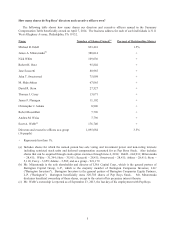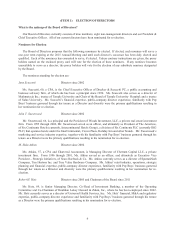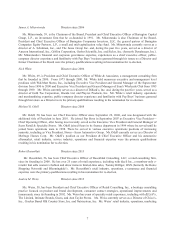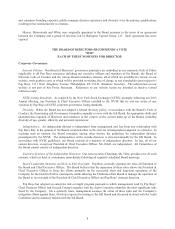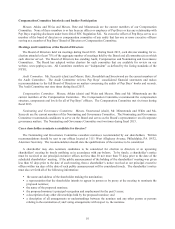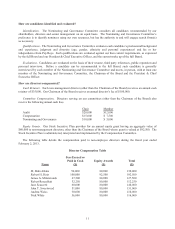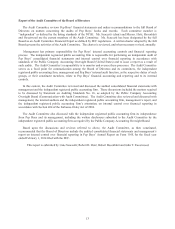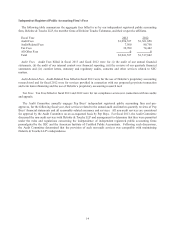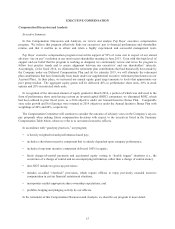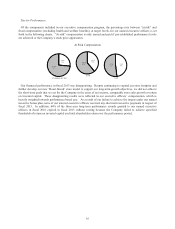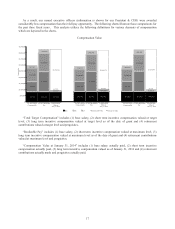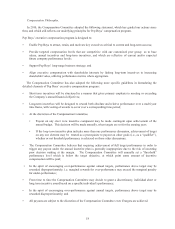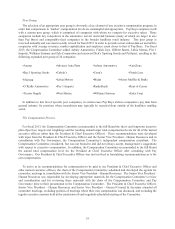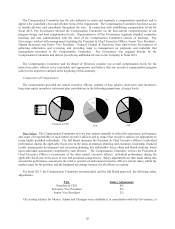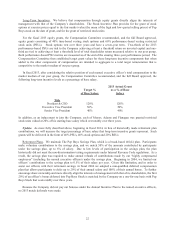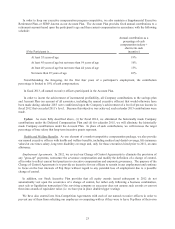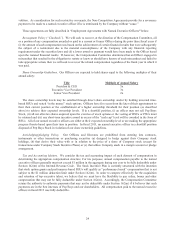Pep Boys 2013 Annual Report Download - page 20
Download and view the complete annual report
Please find page 20 of the 2013 Pep Boys annual report below. You can navigate through the pages in the report by either clicking on the pages listed below, or by using the keyword search tool below to find specific information within the annual report.15
EXECUTIVE COMPENSATION
Compensation Discussion and Analysis
Executive Summary.
In this Compensation Discussion and Analysis, we review and analyze Pep Boys’ executive compensation
program. We believe this program effectively links our executives’ pay to financial performance and shareholder
returns, and that it enables us to attract and retain a highly experienced and successful management team.
Pep Boys’ executive compensation program received the support of 99% of votes cast in respect of our annual
advisory ‘say on pay” resolution at our most recent shareholder meeting in June 2013. Even with this high level of
support and our belief that the program is working as designed, we continuously review and revise the program to
follow best practice trends and to ensure alignment between our executives’ and our shareholders’ interests.
Accordingly, (i) for fiscal 2014, we eliminated the retirement plan contributions that had historically been made by
the Company under our Deferred Compensation Plan and (ii) for calendar 2015, we will eliminate the retirement
plan contributions that have historically been made under our supplemental executive retirement plan (known as our
Account Plan). In their place, we increased our annual equity grant target amounts to levels that approximate our
peer group median. The aggregate equity grants will be delivered 40% in performance share units, 40% in stock
options and 20% in restricted stock units.
In recognition of the increased amount of equity granted in March 2014, a portion of which was delivered in the
form of performance share units having a return on invested capital (ROIC) component, we eliminated ROIC, which
had been utilized in prior fiscal years, as a 2014 objective under our Annual Incentive Bonus Plan. Comparable
store sales growth and Net Earnings were retained as 2014 objectives under the Annual Incentive Bonus Plan with
weightings of 40% and 60%, respectively.
The Compensation Committee will continue to consider the outcome of advisory votes on the Company’s say-on-
pay proposals when making future compensation decisions with respect to the executives listed in the Summary
Compensation Table below, whom we refer to as our named executive officers.
In accordance with “good pay practices,” our program:
• is heavily weighted towards performance-based pay;
• includes a short-term incentive component that is entirely dependent upon company performance;
• includes a long-term incentive component delivered 100% in equity;
• limits change-of-control payments and accelerated equity vesting to “double trigger” situations (i.e., the
occurrence of a change of control and an accompanying termination, rather than a change of control alone);
• does NOT include tax gross-up provisions;
• includes so-called “clawback” provisions, which require officers to repay previously awarded incentive
compensation in certain financial restatement situations;
• incorporates market-appropriate share ownership expectations; and
• prohibits hedging and pledging activity by our officers.
In the remainder of this Compensation Discussion and Analysis, we describe our program in more detail.


